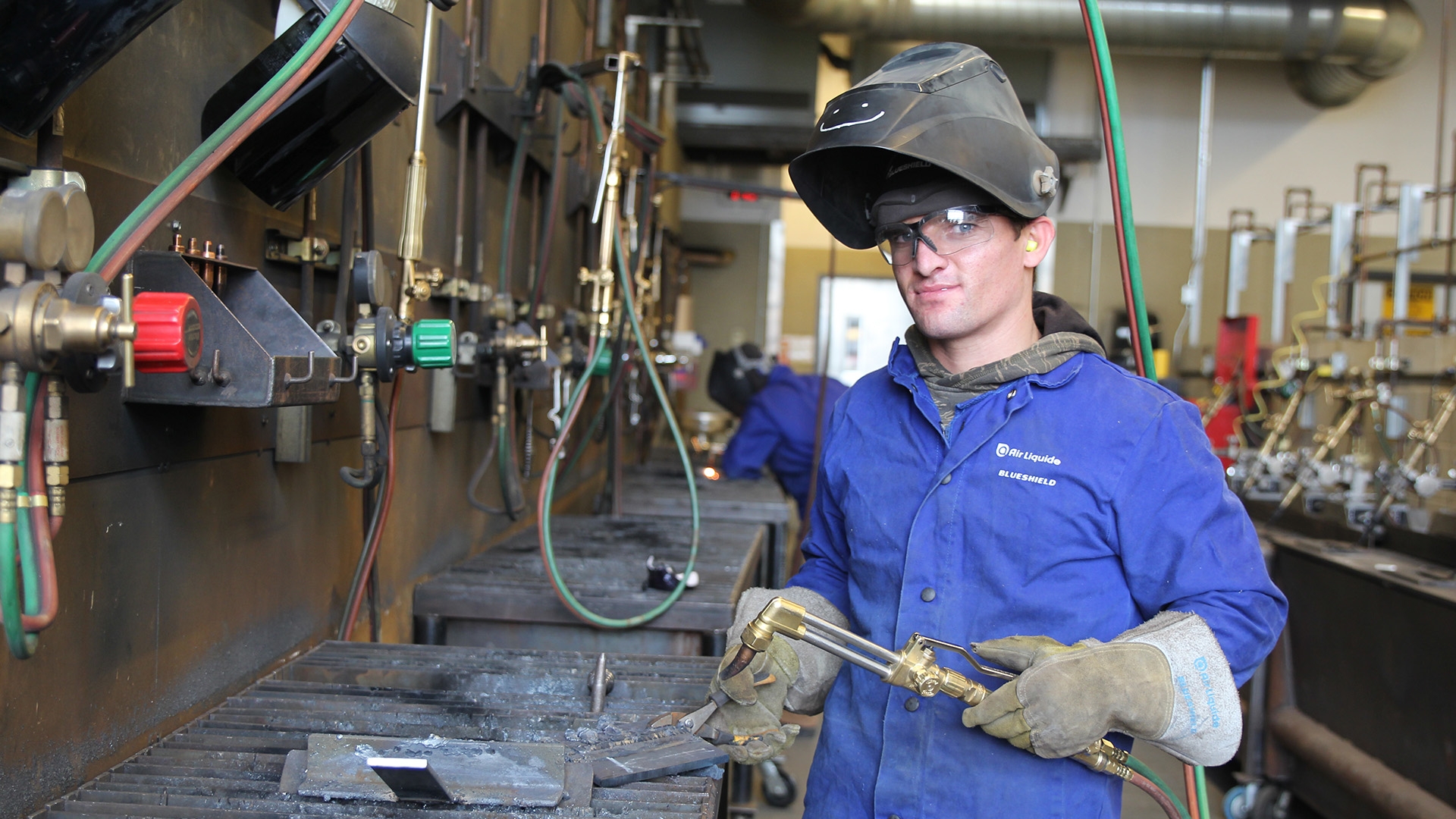Overview
Assiniboine’s four-month Welding certificate provides students with the skills needed for high-quality welding work.
Welders permanently join pieces of metal by applying heat, using filler metal or fusion processes. They join parts being manufactured, build structures, and repair damaged or worn parts. They use various welding processes to join structural steel and metal in vessels, piping and other components. They also use various cutting and gouging processes as well as fabricate parts, tools, machines and equipment used in the construction and manufacturing industries.
Welders may specialize in certain types of welding such as custom fabrication, ship building and repair, aerospace, pressure vessels, pipeline, structural welding, and machinery and equipment repair.
With experience, welders may advance to positions such as lead hand, welding supervisor, welding inspector and project manager. They may contract or be employed by companies such as fabrication shops, steel and platform manufacturers, petrochemical refineries, mechanical contractors, transportation contractors (heavy machinery, aircraft, shipbuilding, railcar repair), and specialized welding shops.
Graduates who register as an apprentice within two years of finishing the program, and you may receive credit for Level 1 in school technical training of Welder apprenticeship.
Program Learning Outcomes
- Complete all work in compliance with the rights and conditions of contractual obligations, provincial and/or national Codes, applicable laws, bylaws, standards and ethical practices in the welding field.
- Comply with health and safety practices and procedures in accordance with current legislation and regulations.
- Fabricate and prepare components for welding.
- Use specialized equipment for cutting and gouging.
- Perform specialized processes such as stud welding, orbital welding and resistance welding.
- Develop and use strategies for ongoing professional development to remain current with industry changes, enhance work performance and explore career opportunities.
- Communicate and collaborate with diverse clients, supervisors, coworkers and tradespersons to complete projects on time and to maintain effective working relationships.
Examples of what welders do are:
- Read and interpret blueprints or welding process specifications.
- Operate manual or semi-automatic welding equipment to fuse metal segments using processes.
- Operate manual or semi-automatic flame-cutting equipment.
- Operate brazing and soldering equipment.
- Repair worn parts of metal products by welding on extra layers.
Success Factors
You might be a good fit for this program if you have or would enjoy:
- A physically demanding occupation.
- Attention to detail.
- Excellent hand-eye coordination.
- Manual dexterity to handle welding equipment and make precise welds.
- Troubleshooting and coming up with effective solutions quickly and efficiently.
- Working in a variety of industrial or production contexts.
The industry and program environment require individuals to:
- Be reliable, punctual, and regularly attend work.
- Communicate effectively with others including suppliers, co-workers, other trades people, safety and building inspectors, manufacturer representatives, customers, and co-workers and apprentices.
- Complete responsibilities requiring standing, stooping, bending, and climbing.
- Demonstrate safety-conscious attitudes and work practices.
- Have the strength, dexterity, balance and stamina required to work in or on equipment.
- Interpret technical documents, drawings, specifications, building codes, regulations, bylaws and standards.
- Listen to direction and act on that accordingly.
- Move around and work within the learning environment, negotiating different areas including stairs and ladders, confined spaces, heights, uneven terrain and scaffolds.
- Using specialized skills in a variety of job site conditions, including working outdoors in extreme warm and cold weather conditions (+30°C to -40°C)
- Work in noisy, dusty and/or fumes areas with appropriate personal protective equipment.
- Work in shifts, schedules, and conditions that are unique to the industry.
- Work safely with occupational hazards of sparks, gases, hazardous fumes, burns, heavy lifting, repetitive stress and exposure to ultraviolet and infrared radiation.
Admissions
Admission Requirements
- A complete Manitoba Grade 12 or equivalent
If you received your education outside of Manitoba, please review the equivalent admission requirements: Interprovincial or International.
English is the language of instruction at Assiniboine. All applicants educated outside of Canada or in a country not on the test exempt list are expected to meet the English language proficiency requirements.
International Applications
If you are an international student (e.g., on a study permit, work visa, visitor visa, or otherwise), you may apply to this program; however, due to the length of the program, you will not be eligible for a post-graduation work permit program.
READY TO TAKE THE NEXT STEP IN YOUR EDUCATION JOURNEY?
Start your online application today and join Assiniboine College!
DON'T MEET ADMISSION REQUIREMENTS?
If you don’t meet admission requirements, visit our Centre for Adult Learning to upgrade courses.
Careers & Connections
Careers
- Manufacturing and rebuilding
- Construction
- Agriculture
- Oil
- Railways
- Mining
- Welding and repair shops
- Aerospace
Connections
Students who successfully complete the accredited program with an accumulative average of 70% or better in the trade subjects and level for which the program was accredited, gain employment and register as an apprentice within two years of graduating, will receive credit for Level 1 in-school technical training and 900 hours in the Welder apprenticeship program.
Assiniboine has a number of agreements with other colleges, universities and professional organizations, making it possible to apply credit taken at Assiniboine to programs at other institutions. For information on agreements, see Articulation Agreements.
Tools & Supplies
Program Checklists, Textbooks, and Supplies
Program Checklists:
Textbooks:
Supplies:
ASSINIBOINE BOOKSTORE
Textbooks, supplies and uniforms may be purchased at the Assiniboine Bookstore at the Victoria Avenue East Campus. Booklists, tool lists and supply lists are available from your school office 30 days prior to the start date of your program.
Technology Requirements
Students in this program are expected to have a computer at home with internet access that meets the technical needs outlined by the program. For more details, see At-Home Computing.
Courses & Costs
Costs
Estimated Program Costs (Domestic students)
| Credits | 43.0 |
| Tuition | $2,680 |
| Course Fees | $1,870 |
| Students' Association fees (including Health Premium) | $490 |
| Estimated textbooks, tools, and supplies | $1,270 |
| Optional/Extracurricular Costs for Program Activities | $680 |
All fees are estimated and subject to change without notice.
Estimated Program Costs (International students)
| Credits | 43.0 |
| Tuition | $11,330 |
| Course Fees | $1,870 |
| Students' Association fees (including Health Premium) | $490 |
| Required Health Insurance | $1,001 |
| Estimated textbooks, tools, and supplies | $1,270 |
All fees are estimated and subject to change without notice. All international students must purchase health insurance. The college adds this fee to your student account and then sends your name and fee to the insurance provider on your behalf.
For more information, visit the Fees and Charges page.
Courses
To graduate with a Welding certificate, students must successfully complete 42 academic credits and 1 practical credit. The minimum passing grade for each course is 60% and is indicated on the course outline. Course failure will result in discontinuance in the program. Course offerings are subject to change and may vary by intake.
Courses
| Title | Credits/CEUs | Elective | Distance | PLAR |
|---|---|---|---|---|
Blueprint Reading for Welders (DRFT-0013)In this course, students learn to recognize all the different parts of a blueprint related to welding. Student learn about welding symbols and the interpretation of them. Students complete sketching in isometric and oblique views. |
2.25 credit(s) | No | No | No |
College Foundations (PEDV-0356)This course improves students' ability to navigate the college experience and environment, including student's rights, roles, and responsibilities. In this course, students reflect on their skills, attitudes, and expectations and develop learning strategies to help them to become successful, resilient, and self-directed learners. The course covers topics such as success in online learning, time management strategies, learning strategies, assessment taking strategies, academic integrity, information and digital literacy, and wellness, among others. It integrates elements of student orientation. |
0 credit(s) | No | No | No |
Communications (COMM-0260)This course includes instruction in techniques to improve both written and oral communication with prospective employers, co-workers and clients. Effective strategies for customer service are emphasized. It also serves to familiarize students with the regulations related to the workplace. As well, students receive an introduction to the use of computer software and hands-on experience with Windows operating system, Internet and email. |
1.5 credit(s) | No | No | No |
Gas Tungsten Arc Welding (WELD-0054)Prerequisites:WELD-0031 Shielded Metal Arc Welding, WRKP-0032 Orientation and Safety, WELD-0053 Oxyacetylene Principles |
3 credit(s) | No | No | No |
Hand and Power Tools (WELD-0034)Prerequisite: WRKP-0032 Orientation and Safety |
1.5 credit(s) | No | No | No |
Math for Welders (MATH-0101)Part of being a good welder is having good math skills. Students learn basic math skills, including fractions and decimals, percentages and ratios, the imperial and metric systems, and geometric formulas. This course presents math skills the way welders use them. |
3 credit(s) | No | No | No |
Metal Forming Machines (METL-0015)Prerequisite: WELD-0031 Shielded Metal Arc Welding |
4.5 credit(s) | No | No | No |
Metallurgy For Welding (METL-0016)In this course, students examine the basic metallurgical properties of steel and the changes that take place during cutting and welding operations. This course also covers basic properties of metals including manufacturing, heat treating, hardness testing, non-ferrous metals and alloys. |
1.5 credit(s) | No | No | No |
Orientation and Safety (WRKP-0032)This course focuses on shop safety, equipment safety and welding safety. Students learn about Apprenticeship and how it relates to the welding trade. Students gain knowledge in climbing, rigging and hoisting. |
4.5 credit(s) | No | No | No |
Oxyacetylene Principles-WLDR (WELD-0053)Classroom lectures and shop demonstrations emphasize personal and shop safety, proper handling and use of equipment and theory and operation of equipment components. This course includes a period of demonstration and instruction in practical gas welding as well as brazing of mild steel. Students will learn different welding positions as well as different welding joints. It also includes theory and demonstration of oxyacteylene cutting of mild steel. |
2.25 credit(s) | No | No | No |
Practicum - WELD (PRAC-0313)Prerequisite: Cumulative weighted grade point average (CWGPA) of 2.0 or greater |
1 credit(s) | No | No | No |
Shielded Metal Arc Welding (WELD-0031)This course focuses on basic shielded metal arc welding (SMAW-Arc) and consists of classroom instruction and shop demonstrations emphasizing personal and shop safety, proper handling and use of equipment, and theory and operation of equipment components. It includes demonstrations and instruction of flat, horizontal, vertical and overhead positions, as well as an explanation and demonstration of test procedures. |
9 credit(s) | No | No | No |
Wire Feed Processes (WELD-0041)This course focuses on basic gas metal arc welding (GMAW-MIG), flux core arc welding (FCAW) and metal core arc welding (MCAW). This course consists of classroom instruction and shop demonstrations emphasizing personal and shop safety, proper handling and use of equipment, and theory and operation of equipment components. In addition, it introduces knowledge of the procedures used to deposit a weld bead using wire feed process equipment in various positions. |
9 credit(s) | No | No | No |




